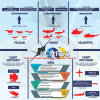Modernization or death: Heed history’s lessons on the F-35
By: Pete Gavares 1 day ago
9035
Capt. Andrew “Dojo” Olson, F-35 Heritage Flight Team commander and pilot, performs aerial maneuvers in an F-35A Lightning II during the Chicago Air and Water Show in Chicago, Ill., on Aug. 18, 2018. (Airman 1st Class Alexander Cook/U.S. Air Force)
If you go to war, you must be equipped to win.
That was the message veteran pilots from the Vietnam War delivered to me when I entered the U.S. Air Force in 1974. The same holds true today. That is why I am concerned when doubts are raised about the future of the F-35 fighter program.
Modernizing America’s aerial arsenal with advanced capabilities is not an optional activity. Failing to do so will undermine the
U.S. military’s effectiveness around the globe and put aircrews at undue risk.
Some historical context here is important: The air war over Vietnam was an incredibly formative experience for the Air Force. The jets airmen took into combat, like the F-4 Phantom and the F-105 Thunderchief, were designed in the 1950s to fight a nuclear conflict. This proved far different than what they encountered in Southeast Asia. Too many men were killed or captured trying to make due with equipment that was not up to the job. Airmen were determined to address these shortfalls in the post-war years by fielding a new “fourth generation” of fighter aircraft designed to incorporate the lessons from Vietnam.
In 1981, I was an Air Force captain stationed at Nellis Air Force Base — home to one of those fighters, the then-brand-new F-16 Fighting Falcon. It was an incredible aircraft, featuring leading-edge technologies such as fly-by-wire flight controls and redundant flight-control computers, unheard of maneuverability, along with unprecedented levels thrust and fuel efficiency.
However, there was one problem: Our early F-16s kept crashing. We lost four aircraft in my first 44 days at Nellis. Wing commanders were lucky to last a month. In fact, there was a macabre joke circulating that if you wanted one of the new jets, just buy an acre of land off the end of the runway and wait.
Similar teething problems afflicted other fourth-generation aircraft. Yet all these aircraft evolved into incredibly capable fighters and have stood as the backbone of U.S. combat aviation for the past 40 years.
All levels of the military and government committed to overcoming the technical obstacles and seeing these fighter programs through to completion. It was literally a choice of modernization or death. If Vietnam-era Air Force fighters could hardly hold their own in the 1960s, there was no way we could execute missions successfully against the Soviet Union’s latest aircraft and air defenses in the 1980s and beyond.
America finds itself at this same juncture today. Fourth-generation fighters like the F-15, F-16 and F/A-18 have served their country well, but they are no longer survivable against modern enemy defenses, and they lack many capabilities necessary for operations in the modern information age.
Successful air combat today and tomorrow demands a fifth-generation solution: the F-35, and lots of them. This new aircraft dominates in the areas that define modern air combat: stealth technology, advanced sensors, computing power and the ability to collaborate in real time with other combat assets.
While last-generation fighters have been modernized to field limited elements of these new capabilities, attributes like stealth cannot be bolted onto a legacy airplane. The idea that we should keep flying fourth-generation capabilities because they are “good enough” and less expensive — though not by much, or for much longer — simply does not reflect reality. Try to sell that to your son or daughter in the cockpit as they take off into airspace controlled by the latest Russian and Chinese weapons systems.
Concerns regarding the F-35’s budget and schedule growth based on early development challenges are valid to a certain extent. But every new military aircraft program — none as complex and ambitious as the F-35 — has hit some turbulence in the early phases. Furthermore, while developing cutting-edge military capabilities is not a risk-free proposition, failing to modernize will always yield a far greater expense — one measured in lives lost and strategic objectives surrendered.
Fighter pilots of my generation were able to execute our missions successfully and make it back to base throughout the Cold War, Desert Storm, Bosnia, Kosovo and beyond because airmen before us stood up and built the fighter inventory they knew reality demanded. The F-35 represents the next step in this journey for the Air Force, Navy, Marine Corps and our allies. Yesterday’s technology will not bring victory in potential conflicts against China, Russia and hostile nations (like Iran) that buy or host their equipment. This nation and our allies need the F-35 now, in quantities that allow our forces to prevail so we don’t have to say “never again” — again.
Pete Gavares served 28 years as a fighter pilot in the U.S. Air Force, retiring as a colonel in 2002. He flew combat missions in Operation Northern Watch.
https://www.defensenews.com/digital...n-or-death-heed-historys-lessons-on-the-f-35/
 .
.














